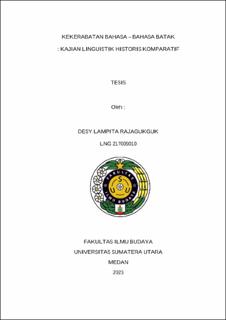Kekerabatan Bahasa – Bahasa Batak : Kajian Linguistik Historis Komparatif
Kinship of Batak Languages Comparative Historical Linguistic Study

Date
2023Author
Rajagukguk, Desy Lampita
Advisor(s)
Dardanila
Widayati, Dwi
Metadata
Show full item recordAbstract
This study aimed to analyze the kinship of the Batak languages and the years of separation between these languages. The method used was descriptive quantitative. The Batak languages were described using the Lexicostatistics technique and the years between languages calculated using the Grotochronology technique. The background of this research was that speakers of Toba, Angkola, Mandailing, Pakpak, Karo and Simalungun languages had different perspectives as part of the Batak family. This difference in views could be seen among people who thrive on social media, such as the "Karo Not Batak" community account with 12,900 followers on Instagram. The data used in this study were 400 vocabularies consisting of 200 Swadesh vocabularies and 100 basic vocabularies by Gudschinsky (1956) and 100 basic cultural vocabularies, starting from the community life cycle (birth, marriage, death) and livelihood cycles (planting, cleaning and harvesting). Data collection was carried out using the record-recording technique which was carried out with informants as native speakers of each language. Based on the research conducted, the following findings were obtained. The highest percentage of kinship and the lowest separation time is seen in the Mandailing-Angkola language (94.5% and separation in 1833-1953). The lowest level of kinship and the largest number of years of separation is seen in the Toba language - the Karo language (63.25% and separated in 897 - 1039. Based on the grouping results, it is known that the Toba language is in a language group with the Mandailing language, and the Angkola (southern Batak family), while the Pakpak and Karo languages belong to the northern Batak family, and the Simalungun language itself belongs to the eastern Batak family. In addition, this study succeeded in proving that the Karo, Toba, Pakpak, Simalungun, Mandailing and Angkola languages belong to the Batak family. However, what needed to be straightened out was the assumption that the Toba language which was connoted as Batak language was a language that derived from other Batak languages because of differences in proximity from one language to another such as Toba - Angkola - Mandailing languages were in the language group while other languages such as the Toba - Karo - Pakpak languages are not in a language group, but rather a family group.
